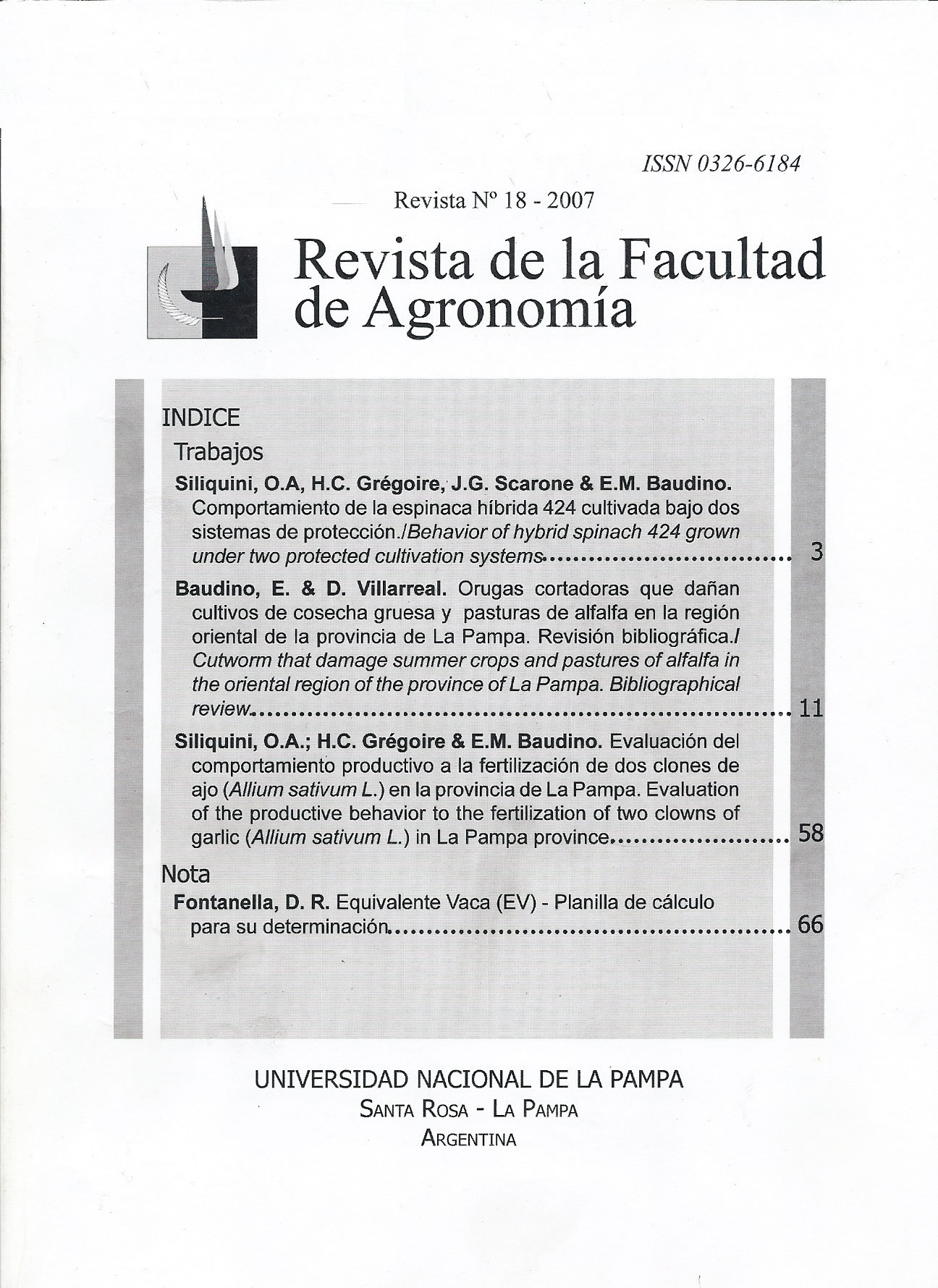Evaluation of the productive behavior to the fertilization of two clowns of garlic (Allium sativum L.) in La Pampa province
Keywords:
Chinese, Colored, fertilization,Abstract
The garlic (Alium sativum L.), it is a species belonging to the family of the Allied. Argentina is one of the principal producing countries and the second world exporter of garlic, after China, the major quantity is exported from January to June, To evaluate the culture, in not traditional zones as La Pampa, it is a valuable contribution, where environmental factors conjugate not alone but also characteristics of soil, quality of water, managing of culture, workforce, and response to fertilization, plagues, diseases, crop, yields and marketing. The aim of the work was to evaluate the productive behavior of two clowns of garlic, "Chinese" and "Colorado" and his response to the fertilization with sulphate of ammonium in one and two applications. The plantation was realized in the garden of the Facultad de Agronomía, UNLPam, April 15, 2005, in a design of complete blocks at random by 4 repetitions, the experimental unit consisted of a plot of two lines of 5 m. Of length, to 0.60 m between lines, with two lines of bordure. There were fertilized by sulphate of ammonium 30/7 in the treatments 1 (the only application) and 2, and 30/9 in the treatment 2 (double application) because of 50 kg.ha-1 every time. The values were compared by means of ANOVA, and Tukey's test with a = 0,05. Bearing in mind the weight of dry clean garlic, the results indicate that both clowns answered favorably to the double fertilization, obtaining significant differences between treatments, obtaining major production with double fertilization, with regard to the unique fertilization, and in turn the plots with an alone fertilization produced more in weight that the plots witness without fertilizing. Also significant differences between clowns were obtained. The results reveal the major yield of the "Chinese" clown in the different treatments respect of the clown "Colorado".
Downloads
References
Brewster, JL. 1997. Onions and garlic, /n: Wien, HC (Ed). The Physiology of Vegetable Crops CAB Intemational, New York, pp. 581-619.
Burba, J.L. 1991. Documento N° 1 AJO. I Curso de Especialización en Cultivos Hortícolas. Cinco Saltos Río Negro. Ministerio de Recursos Naturales Provincia de Río Negro. Facultad de Ciencias Agrarias Universidad Nacional del Cómahue.
Burba, J.L. 1991. 50 consejos Útiles para la producción de Ajo. Agro de Cuyo 1 Año 1. INTA Centro Regional CUYO Mendoza. Argentina.
Burba, J.L. 2005. INFORAJO. Boletín de difusión del Proyecto AJO/ INTA. (ISSN 0327-4888) N" 2.
Corvo Dolcet, S. 2003. Cultivo del Ajo en la Argentina. Secretaria de Agricultura, Ganadería, Pesca y Alimentos. Subsecretaría de Agricultura, Ganadería y Forestación. Dirección de Agricultura. 9 p.
Ghironi, E. M.; Muguiro A. F. 2008. Caracterización del productor hortícola de La Pampa. Publicado en las Actas del XXXI Congreso Argentino de Horticultura. Mar del Plata, provincia de Buenos Aires, del 30 de Septiembre al 3 de Octubre de 2008. ARGENTINA.
Lipinski, VM. 1996. Maximizando la producción de Ajo y Cebolla: manejo de la fertilización. Fertilizar INTA. N" 5 Diciembre de 1996;
Pórtela, J.A. 2003. La Calidad como Meta. INTA La Consulta, Mendoza. RIA Idia XXI. pp. 50-54
RÍOS, P; Capovila, P; Siliquini, O; Grégoire, H. 1995. Respuesta del ajo (Allium sativum L) clon Colorado a la fertilización nitrogenada. Publicado en las Actas del XVIII Congreso Argentino de Horticultura. Río Hondo, Santiago del Estero. Septiembre de 1995. ARGENTINA.
Siliquini,O.A.;Mendoza,M. Diagnostico sobre las características de la comercialización hortícola en Santa Rosa La Pampa. Publicado en las Actas del XXXI Congreso Argentino de Horticultura. Mar del Plata, provincia de Buenos Aires, del 30 de Septiembre al 3 de Octubre de 2008. ARGENTINA.
Vergara, G. T, Casagrande, G. 2005. Cátedra de Climatología Agrícola. Facultad de Agronomía UNLPam.
Vigliola, M1986. Manual de Horticultura. Editorial Hemisferio Sur.
Downloads
Published
Issue
Section
License
La Editorial de la Universidad Nacional de La Pampa (EdUNLPam) exigirá a los/as autores/as la firma del siguiente documento:
La EdUNLPam lleva a cabo la publicación del artículo: (Título del Artículo) en SEMIÁRIDA Rev.Fac.Agron UNLPam ISSN 2362-4337 (impresa) ISSN 2408-4077 (en línea), del cual el/los abajo firmantes son autores de una o más partes. En el mismo acto, el/los autores entregan exclusivamente a la EdUNLPam todos sus derechos protegidos por las leyes de propiedad intelectual que rigen en la Argentina para reproducir, publicar, editar, fijar, comunicar y transmitir públicamente en cualquier formato o medio impreso o electrónico, inclusive internet, el artículo enviado a publicación e incluirlo en índices o bases de datos nacionales e internacionales. A cambio, la EdUNLPam entrega a los autores la autorización para la publicación o reimpresión con ines académicos y educativos en cualquier libro o medio de divulgación, con la sola obligación de citar el artículo original publicado en la EdUNLPam. Cada autor acuerda en que el material provisto a la EdUNLPam es un trabajo original, que no ha sido impreso o publicado en cualquier otro medio con anterioridad y que no vulnera derechos de terceros. El Primer autor tendrá la posibilidad de leer y corregir el artículo ya editado como “prueba de galera”, pero si el autor no devolviera esas correcciones de la prueba de galera dentro del tiempo especificado, el proceso de producción y publicación podrá proseguir sin la aprobación del autor. El/los autor/es no recibirán compensación monetaria de la EdUNLPam por el uso del material contenido en este artículo y asumen la responsabilidad de las opiniones vertidas en él.






.png)



22.png)



.jpg)




.jpg)
